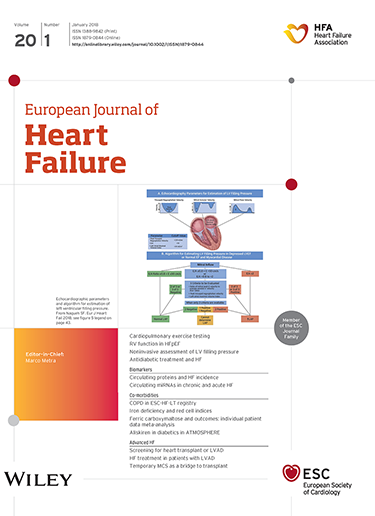Prediction of new-onset atrial fibrillation in patients with hypertrophic cardiomyopathy using machine learning
Abstract
Aims
Atrial fibrillation (AF) is the most common sustained arrhythmia among patients with hypertrophic cardiomyopathy (HCM), leading to increased symptom burden and risk of thromboembolism. The HCM-AF score was developed to predict new-onset AF in patients with HCM, though sensitivity and specificity of this conventional tool are limited. Thus, there is a need for more accurate tools to predict new-onset AF in HCM. The objective of the present study was to develop a better model to predict new-onset AF in patients with HCM using machine learning (ML).
Methods and results
In this prospective, multicentre cohort study, we enrolled 1069 patients with HCM without a prior history of AF. We built a ML model (logistic regression with Lasso regularization) using clinical variables. We developed the ML model using the cohort from one institution (training set) and applied it to an independent cohort from a separate institution (test set). We used the HCM-AF score as a reference model. We compared the area under the receiver-operating characteristic curve (AUC) between the ML model and the reference model using the DeLong's test. Median follow-up time was 2.1 years, with 128 (12%) patients developing new-onset AF. Using the ML model developed in the training set to predict new-onset AF, the AUC in the test set was 0.84 (95% confidence interval [CI] 0.77–0.91). The ML model outperformed the reference model (AUC 0.64; 95% CI 0.54–0.73; DeLong's p < 0.001). The ML model had higher sensitivity (0.82; 95% CI 0.65–0.93) than that of the reference model (0.67; 95% CI 0.52–0.88). The ML model also had higher specificity (0.76; 95% CI 0.71–0.81) than that of the reference model (0.57; 95% CI 0.41–0.70). Among the most important clinical variables included in the ML-based model were left atrial volume and diameter, left ventricular outflow tract gradient with exercise stress and at rest, late gadolinium enhancement on cardiac magnetic resonance imaging, peak heart rate during exercise stress, age at diagnosis, positive genotype, diabetes mellitus, and end-stage renal disease.
Conclusion
Our ML model showed superior performance compared to the conventional HCM-AF score for the prediction of new-onset AF in patients with HCM.


 求助内容:
求助内容: 应助结果提醒方式:
应助结果提醒方式:


